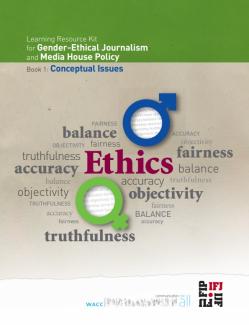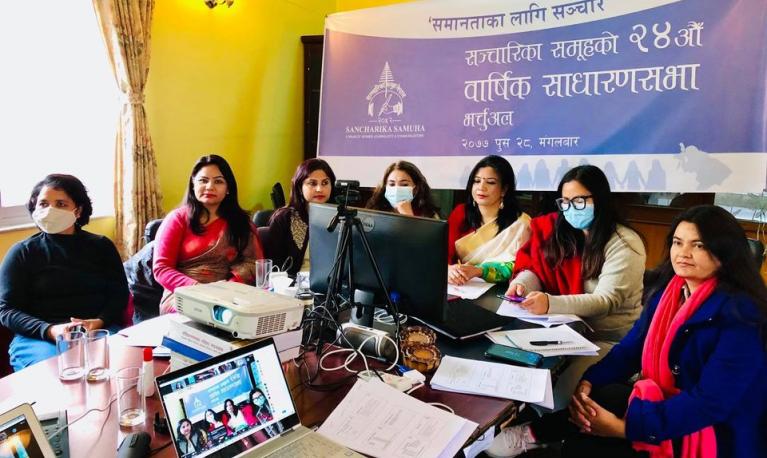
- Case study
- 29 Octubre 2021
Monitoring the media and advocating for national change: the Global Media Monitoring Project
- Author: Faria A. Nasruddin
- Published by: ALIGN
The Global Media Monitoring Project (GMMP) emerged from the global women’s movement and the 1994 conference on gender and communication, ‘Women Empowering Communication’, held in Bangkok. The blueprint for the GMMP is Section J of the Bangkok Declaration, ‘Women and the media’, which recommends media monitoring by civil society to identify ‘where women [are], how women [are] portrayed and represented’ in the media and to improve both.
The GMMP is a joint project between the World Association for Christian Communication (WACC) and ISIS International in the Philippines. Together these organisations began to collect data on the news media: in 70 countries at first, and now in more than 116 worldwide.
Theory of change
WACC, which hosts the GMMP, believes that a ‘fair and balanced portrayal of women in the media plays a critical role in advancing gender equality and women’s empowerment’. The GMMP promotes, therefore, ‘critical media research to generate evidence for education, awareness, training and advocacy, supporting women’s use of media for their own empowerment and for the development of their communities’. In other words, GMMP’s research forms the basis for actionable change from local communities to the wider public agenda.
Methods


The GMMP comprises a one-day media study, collecting data on the presence of women in the news media compared to men, and on gender biases and stereotypes, as well as gender-sensitive reporting frameworks. It is conducted once every five years, with the most recent study – Who Makes the News – published in 2020.
The current indicators are ‘people in the news’, ‘reporting and presenting in the news’ (anchors, reporters, presenters), and 'news content’. Taken together, these gauge the quality of representation in the news, and the extent to which stories challenge gender stereotypes, integrate issues of gender equality, or raise issues of gender policy, human rights, and more).
The study is longitudinal and has, therefore, retained its original indicators while adding new ones to clarify or refine questions and take stock of emerging issues. For example, and for obvious reasons, questions related to the COVID-19 pandemic were added to the 2020 edition of the GMMP, based, as noted by Sarah Macharia, Global Coordinator of the GMMP, ‘… on the fact that we were now able to cross tabulate and sift out and analyse all the COVID-related stories, whether it was COVID and politics, COVID and the economy, or COVID and health’.
Evidence of change
The findings of the GMMP are used by gender and communications groups across the globe to train media practitioners, provide media literary education for consumers, and for advocacy. Macharia notes that the GMMP works closely with a global network of social organisations that leverage the findings from the GMMP to drive change at the highest levels. As a result, she says, ‘We've been able to get recommendations pushed at the UN Commission on the Status of Women to recognise media as a key player in achieving gender equality in all other areas. Because media is often left on the side-lines, even while it is often said that social norms are sticky’.
Advocacy work generated by the GMMP has, for example, been used in Argentina to institute a national law on the portrayal of women and gender minorities in mass media. The law, which took effect this year (2021), mandates public media to ‘promote gender parity from a sexual diversity perspective in order to eradicate sexist and patriarchal stereotypes’ and encourages private media to take part by prioritising the ‘allocation of institutional advertising’ for companies that meet the gender parity requirements set out under the new law.


for media professionals such as
this one. ©GMMP
In addition, the results of the GMMP are used for training. For example, the GMMP has partnered with the International Federation of Journalists to create a toolkit for media professionals on gender-ethical journalism. In another case, the GMMP findings were adopted by the Inter-African Network for Women, Media, Gender and Development (FAMEDEV) to develop training workshops in francophone West and Central Africa. And in Malta, the Gender Advisory Committee of the Broadcasting Authority uses GMMP in to guide its research and training programmes.
Looking to the future
The GMMP aims to address some key methodological challenges. In particular, it will continue to enhance its ability to capture data on intersectionality. Significant progress has been made in recent years, including the inclusion of context-specific qualitative analysis of stereotypes that has required the extensive training of the GMMP analysts, as Macharia explains: ‘So, for example, what would be a stereotype in North America may not be a stereotype in... Kenya; what is a stereotype in Asia may not be as stereotype in Europe.’ She goes on to point out: ‘But I think we managed to achieve [interpretation of qualitative metrics] with the examples that we give and through the opportunity to discuss the questions well ahead of time with people from different backgrounds—that makes interpretation easier.’. These qualitative metrics—stereotypes and intersectionality—are more difficult to measure in a uniform and comparable way at a global scale. As a result, the GMMP has only been able to undertake a region-wide analysis on the representation of indigenous peoples in Latin America. Elsewhere the GMMP has been limited by the national context for the intersectional analysis of gender, race, ethnicity, class and sexuality, amongst other facets of identity. This is where the GMMP will focus its efforts in the coming years.
- Tags:
- Broadcast media, Media
- Countries / Regions:
- Global
More case studies
Interview
15 Diciembre 2021

Interview
6 Diciembre 2021

Case study
1 Noviembre 2021

Case study
1 Noviembre 2021

Case study
29 Octubre 2021

Case study
29 Octubre 2021

Case study
29 Octubre 2021

